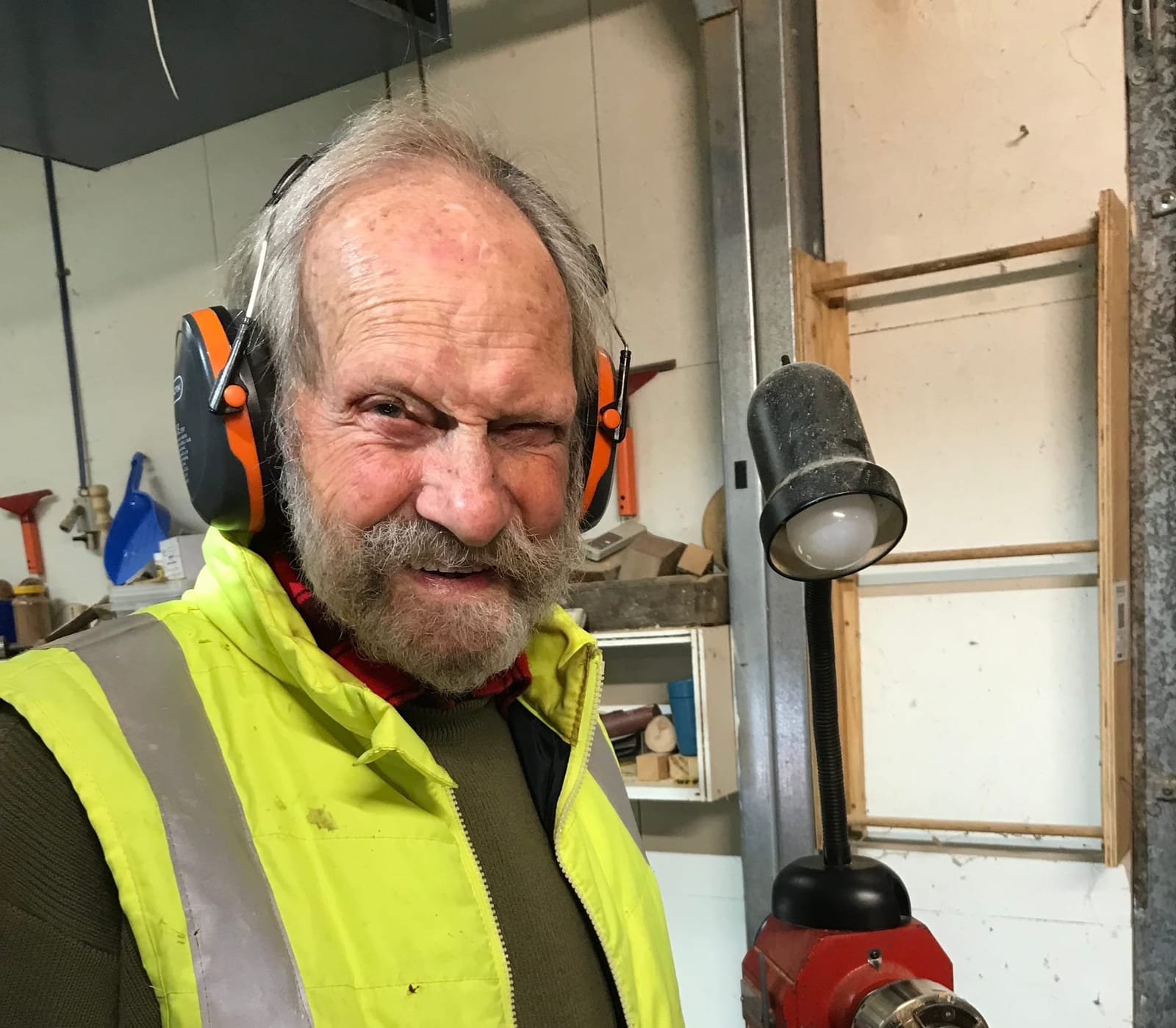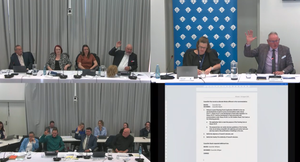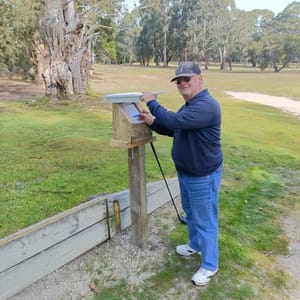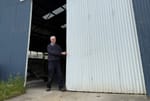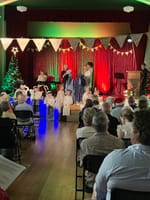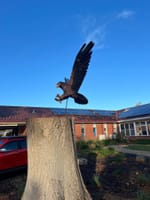Celebrating a century of courage, creativity and community

Foster luminary Bruce Crowl (right) and his fellow WW2 veterans laid wreaths to commemorate 80 years since Victory in the Pacific in Townsville on 15 August. Bruce will celebrate his 100th birthday on the 1st of September. It's a remarkable milestone for a life rich in service, creativity and community - a contribution he continues to make today. Read more about Bruce's remarkable life on p?. Photo Jessica Naunton, ABC North Queensland..
On 1 September, Bruce Crowl, distinguished Australian and long-time Foster resident, will celebrate his 100th birthday. It’s a remarkable milestone for a life rich in service, creativity and community and a contribution he continues to make today.
Bruce was born in Bendigo, just 24 years after Australia became a commonwealth, and not long before the onset of the Great Depression of the 1930s. During the Depression years, unemployment skyrocketed, wages were cut, many people lost their homes, and families relied on charity, soup kitchens, and barter to survive.
Bruce’s family was lucky. His father’s work at the Victorian Railways enabled them to keep their heads above water. While Bruce’s parents didn’t have the benefit of a great education themselves, they could see that those who fared the best in difficult times were the well-educated engineers, and they were determined that’s what their only child would be. So, when Bruce completed primary school in Kerang, they borrowed money to send him to the best school possible - Melbourne’s Scotch College.
Bruce spent four years at Scotch and admits that he wasn’t a natural scholar. His heart was not in the science subjects needed for engineering, and he failed four of the six subjects he needed to matriculate. He sat supplementary exams - enough to get him the Intermediate Certificate, but not enough to advance his engineering prospects.
Roundly rejected by Melbourne Tech’s Engineering school for his lack of science subjects, he enrolled in Art School instead, but Bruce’s dad would have none of it. He promptly enrolled Bruce in Swinburne’s School of Engineering.
“It was the most miserable year I’ve ever spent in my life! I was doing night school as well, doing 12 subjects altogether and I passed 4: Engineering Drawing, Engineering Practice, Machine Shop Practice and English,” Bruce remembers.
“In 1942 I started working in a little engineering shop in Melbourne, and in 1943, when I turned 17 and midway through WWII, I got out of that engineering place as fast as I could and enlisted in the Navy.”
After five months of training at HMAS Cerberus, Bruce was assigned to the Signals section, to communicate with other ships using morse code, semaphore, and flags.
In 1943, when he turned 18, Bruce was posted to HMAS Australia, the senior Australian warship, and the flagship of the Australian contingent in the liberation of the Philippines.
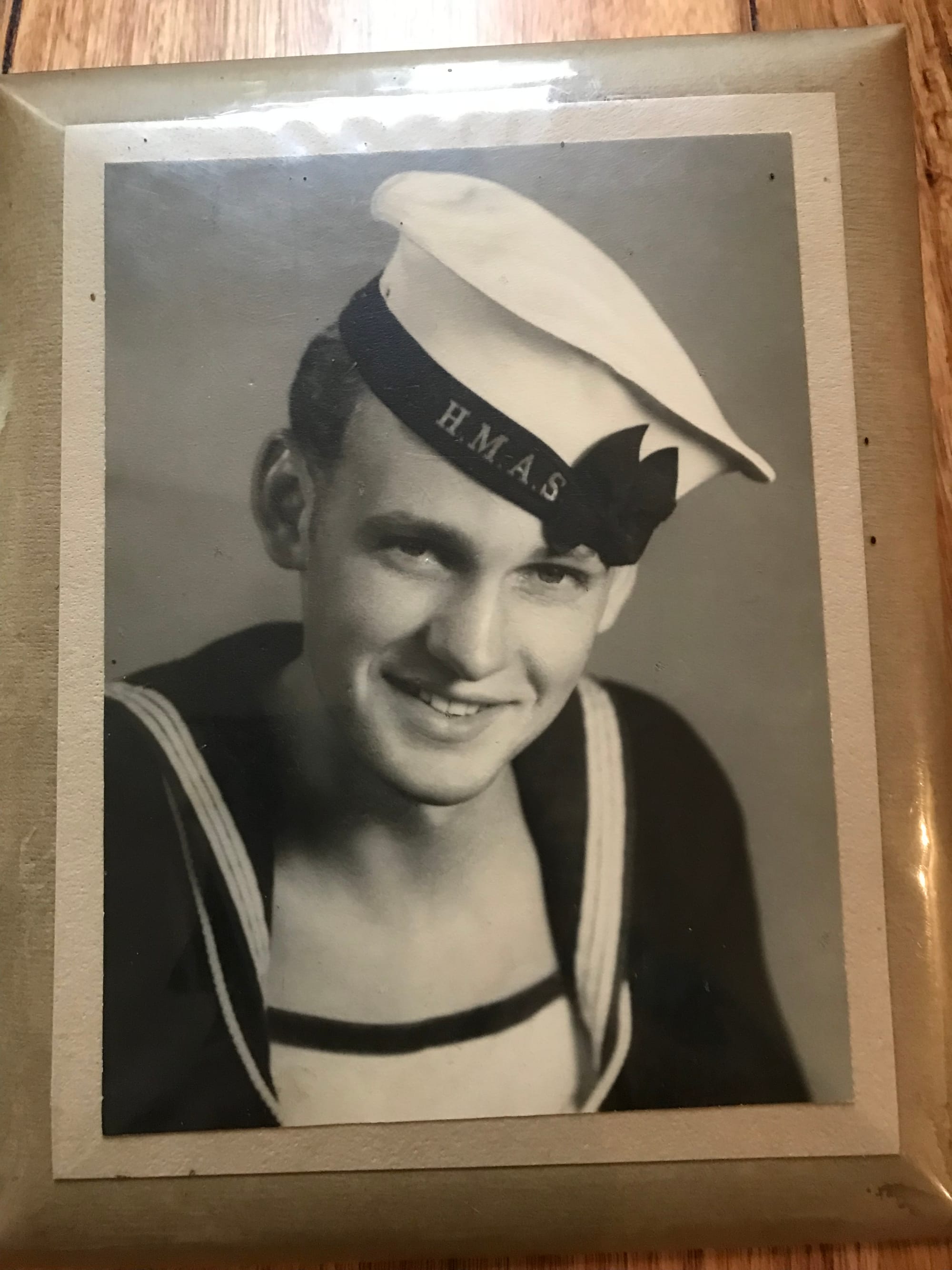
Australia was engaged in pivotal campaigns, most notably the Battle of Leyte Gulf in October 1944.
Bruce recalls the battle in vivid detail.
“It was 6.05 am on October 21, 1944, just as Allied forces were preparing to land at Leyte in the Philippines, when a Japanese aircraft deliberately crashed into Australia’s bridge. This was before ‘kamikaze’ was recognised as an official Japanese tactic, making it one of the first, if not the first instance, of such an attack.
“While the aircraft’s bomb didn’t explode on impact, it killed the ship’s commanding officer and many others - 30 officers and crew in all. The burning aviation gas caused terrible burns, and 64 were injured, including the Rear Admiral, the taskforce commander at the time. Fires broke out, communications were badly damaged, and the forward superstructure was heavily wrecked.
“We were really frustrated that we couldn’t go and check on our mates on Flag Deck, but the sick-bay party gathered up all the dead and injured to take them to the Seamen’s Rec Room where the surgeon, Commander Jim Flattery attended as best he could. The sailmaker, Bob Moore, would have immediately started cutting canvas for shrouds for the officers, or gathering their own hammocks for the sailors.
“My work station was immediately behind the Bridge, so we were very lucky”, Bruce says. Despite the damage, Australia was able to withdraw under her own steam for repairs.
“When in open waters, we buried our dead and proceeded to a US air base hospital in Manus to land our injured.
“They repaired us at an American base, and while the Americans worked on the ship, we were able to relax, which was good.
“Australia returned to service in late November and we headed back to the Philippines for the next assault. We joined a convoy of 672 ships spanning 65 km; it was an amazing sight. In January 1945, Australia seemed especially targeted by the Japanese, as five more kamakazes hit us, making ours one of the most frequently kamikaze-struck Allied ships in the war – but despite tremendous damage she survived them all.”
Reflecting on those wartime days, Bruce has referred to HMAS Australia as the “lucky ship.”
Later honoured at Melbourne’s Shrine of Remembrance, Bruce, one of the last survivors of the Battle of Leyte, laid a wreath during the unveiling of Australia’s first commemorative plaque for Leyte Gulf.
When the war ended in 1945, and at the age of 21, Bruce returned to civilian life, and picked up where he had wanted to leave off – enrolling in art school at Melbourne Tech, in the Architecture Department.
A pivotal moment in his new-found career came when he completed the Crawford School’s program for radio announcing and radio acting, and when an ad appeared in The Age for a radio announcer, he was quick to apply.
“I went along to The Age’s newsroom and read last night’s news, which was sent out to three regional radio stations. The next day they gave me a train ticket to Hamilton. I was with 3HA Hamilton for two or more years, and then on Hamilton Cup Day 1958, when my wife was at the races and I was on duty, an electrical fault at home started a fire and our house burnt down. It was the impetus for us to move on.
“With the insurance payout in hand, we bought a new 10-horsepower Ford Prefect, and headed west. We shipped two tea-chests full of possessions to Perth, threw everything else on the back seat of the car and drove across the Nullarbor to a new job as radio presenter at commercial station 6KY, where I stayed for a couple of years.”
In 1958 Bruce joined the ABC as a radio presenter, and two years later, when television began in Perth, opportunities opened up that would shape the rest of his life.
“Working in television in those days at the ABC was literally starting from scratch. No one knew anything about it. I was drawing graphics for school broadcasts, I was directing cameras, and I was doing 5-minute interviews on camera. And as a producer, I pointed cameras for sporting events like tennis and football – it was an interesting time.
“I did a course in television acting at the Perth Tech and subsequently got jobs.”
Family events caused Bruce to return to Melbourne, where film and television opportunities abounded, thanks to a chance meeting with an agency couple who got him interested in acting for the soaps and films that were being made around Melbourne.
“I had whiskers then, which I have now, but at that stage in Melbourne you had to be clean shaven, because they were doing war films, so I ended up doing cowboy films, including Five Mile Creek, which starred a very young Nicole Kidman.”
Bruce went on to showcase his talent as a reliable character actor in some of Australia’s favourite TV series and films. Among his credits are Bush Christmas (1983), Neighbours (1989-94), Prisoner: Cell Block H (1986), The Flying Doctors (1989), Janus (1995), Sons and Daughters (1987), PD Law (1989), Quigley Downunder (1990) and Law of the Land (1994-99).
His stage career also flourished.
“I was the founding director of a start-up theatrical group on the Mornington Peninsula, which produced one or two plays a year, which were well received. More importantly it’s where I met my new life partner, Kate, and we married.
“What brought us to Foster? Kate’s parents were in their 90s and still on the farm at Hoddle. We decided we should be close to family and realised that Foster Amateur Music and Drama Association (FAMDA) was very strong. So, we bought a house in Mine Road and we both proceeded to get heavily involved with FAMDA, which had really good actors and directors.”
Bruce’s extensive, multi-award winning career with FAMDA is well documented. He was adept as a director and technical expert, often multi-tasking across set design, construction, props and stage crew, as well as acting.
His craftsmanship in set construction was repeatedly recognised, culminating in awards for technical achievement.
“I enjoyed acting and directing, but I really enjoyed set building and working with Geoff Davey because I enjoyed converting his two-dimensional outlines to a three-dimensional jigsaw. Between us we created some amazing sets that won several coveted awards.”
His nominations and awards include for A month of Sundays (2003), Woman in Black (2001), Oliver! (2007-09), The Shoehorn Sonata (2012), and Hotel Sorrento (2002).
Bruce initiated FAMDAs annual One Act Play Festival, which marks its 23rd anniversary this year. The festival draws amateur theatre companies from around Victoria to Foster on the last weekend of August, to vie for the top prize that is named in his honour. The Bruce Crowl Award for Most Outstanding Production offers a $1,000 prize to the winning company, thanks to the generous support of the Bendigo Bank.
Bruce’s contributions continue to be central to FAMDA’s success, helping to sustain vibrant live theatre in regional Victoria. He was bestowed Life Membership of FAMDA in 2007.
This year, on August 31 – the eve of his 100th birthday - Bruce and Kate will perform the much-loved one-act play, Dinner for One. It’s a performance not to be missed.

If theatre is the Crowl’s first love, then the world of horticulture is not far behind. Their showpiece garden in Foster is the envy of all who are lucky enough to see it, and regularly features in open garden day events. Bruce and Kate work in their garden every day.
Their active involvement in the Welshpool & District Horticultural Society over many years, particularly through their contribution to the annual flower show, and regular outings to some of Australia’s best gardens, culminated in the society awarding both Bruce and Kate Life Membership in 2024, as recognition of their dedication to the club and local horticulture.
Today, Bruce’s design and building skills are put to good use at Foster’s Men’s Shed, for the benefit of the Horticultural Society, where at the moment he is working to restore the steps at the Welshpool Hall and make things for sale as a fundraiser for the nursery and flower show, which are held there. As he says, it gives him a break from kneeling down weeding every day.
Now on the cusp of his 100th birthday, Bruce’s ongoing presence at community events reflects his continued dedication to serving the community he loves. Whether laying wreaths as a WWII veteran at civic ceremonies or supporting local theatre and horticulture, he remains an inspiring figure of continuity between Australia’s wartime past and its vibrant rural present.
And the key to Bruce’s energy and ongoing good health?
“I haven’t eaten meat for 60 or 70 years. We eat no preservatives except in cheese. We make homemade soup and eat fish 5-6 times a week. And, because of Kate’s limited diet, we eat very simply, and I think that has a lot to do with my health”, he says.
As September approaches, Bruce Crowl’s centenary invites us to celebrate not just his longevity, but a life defined by courage, creativity and an enduring commitment to service. His story reminds us of the power of individual resilience, and the lasting impact that one person can have across generations.
Here’s to Bruce Crowl! May his 100th year be filled with good health, warm tributes, and the same vibrant community spirit that has defined his century-spanning journey. Linda Giddy

